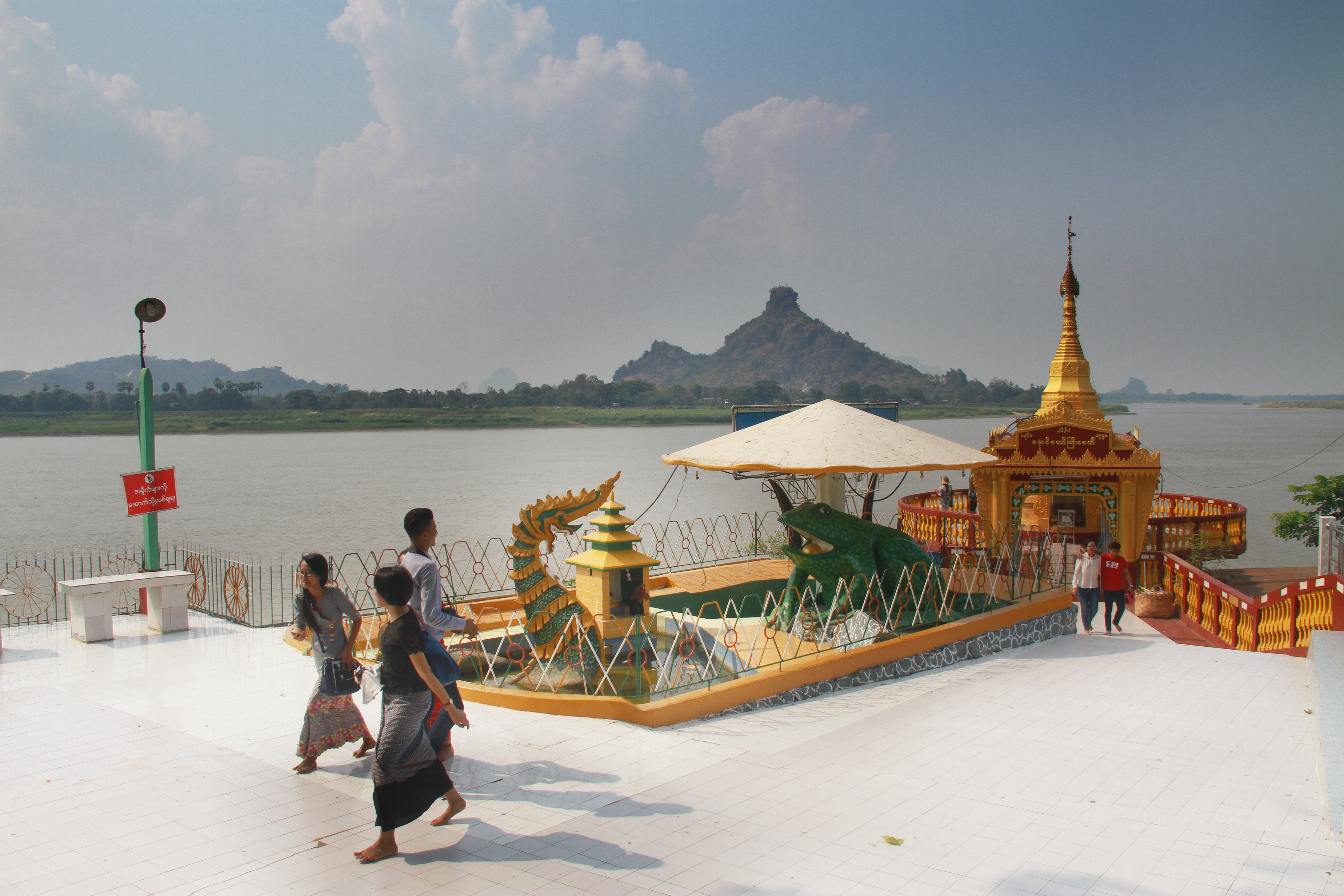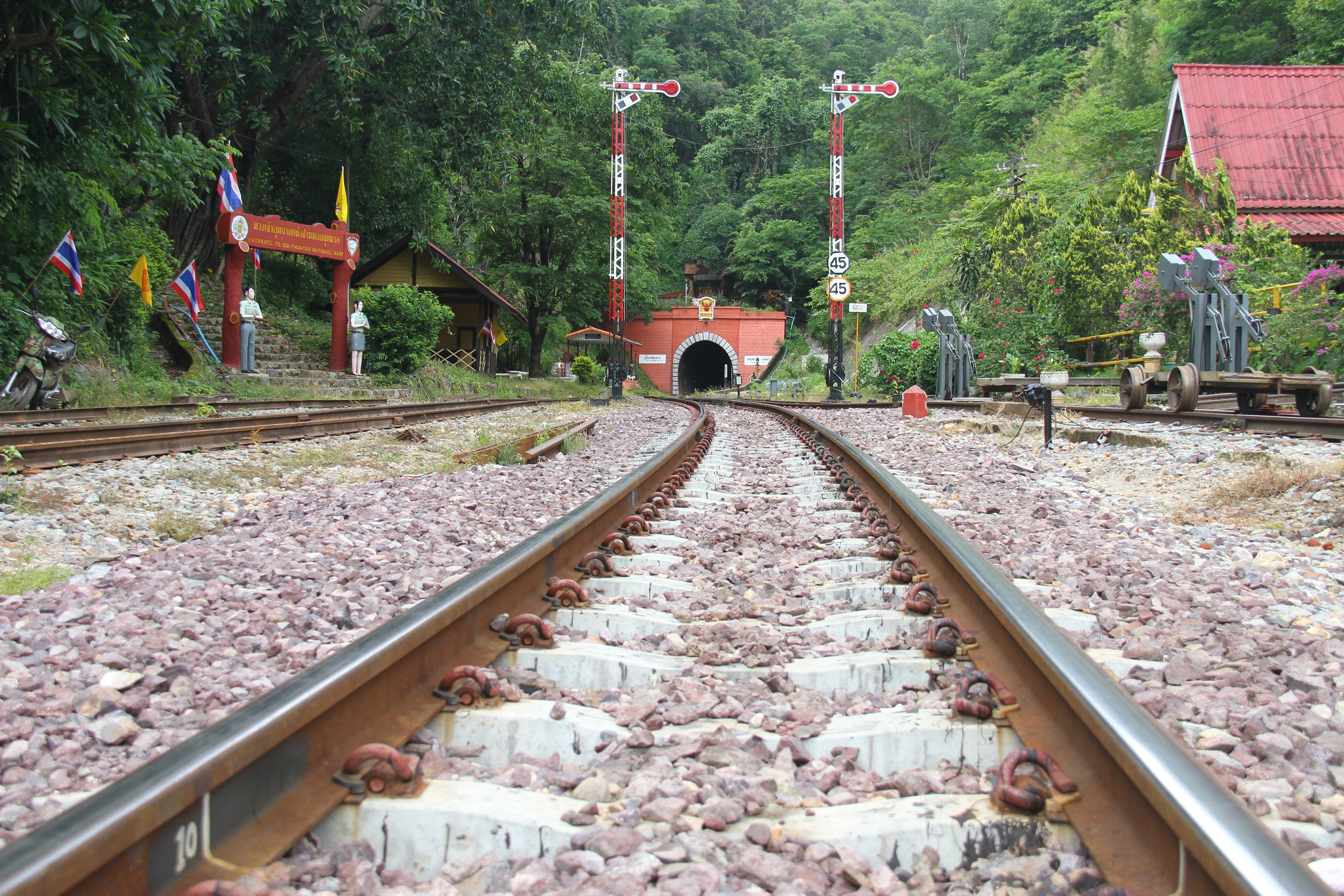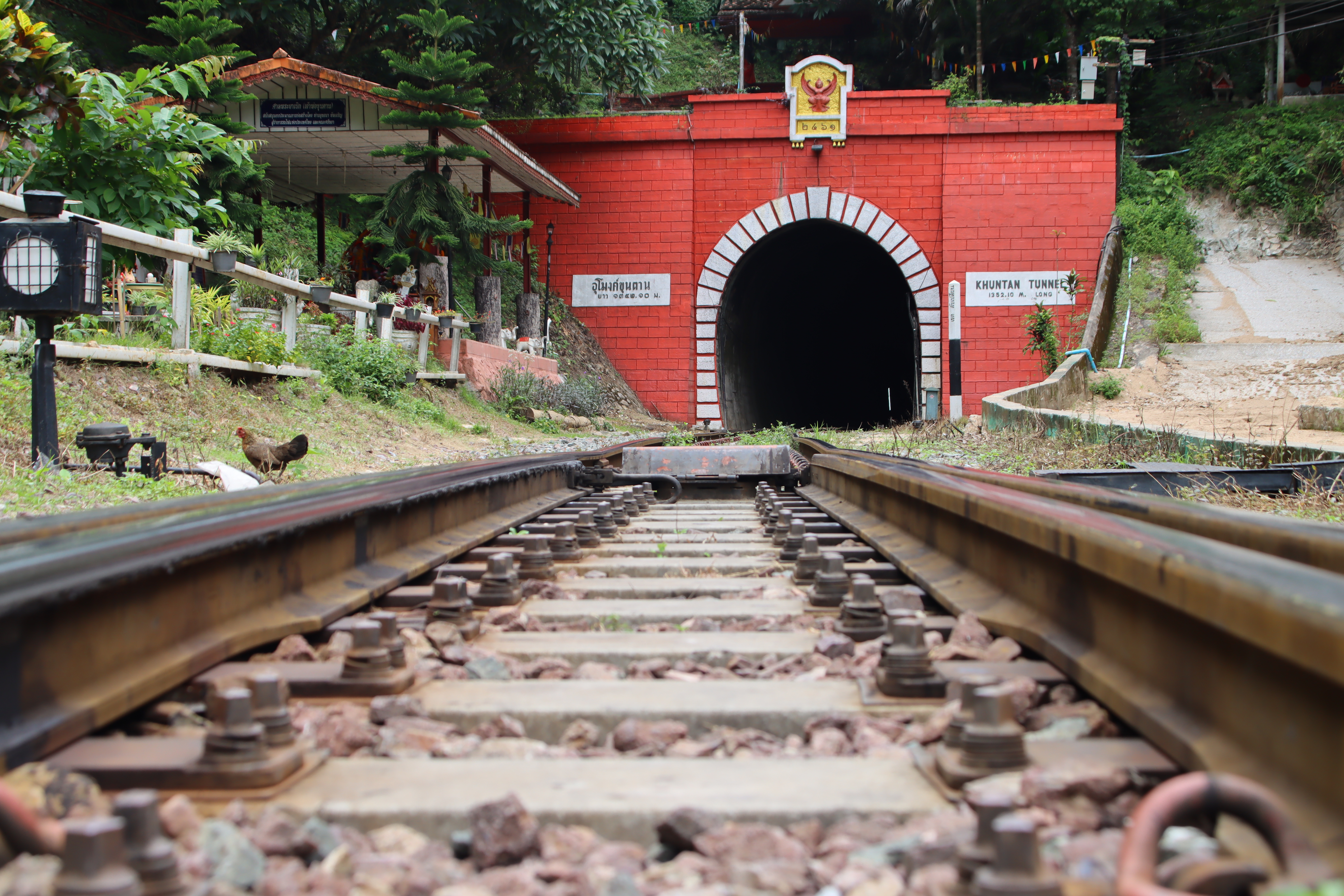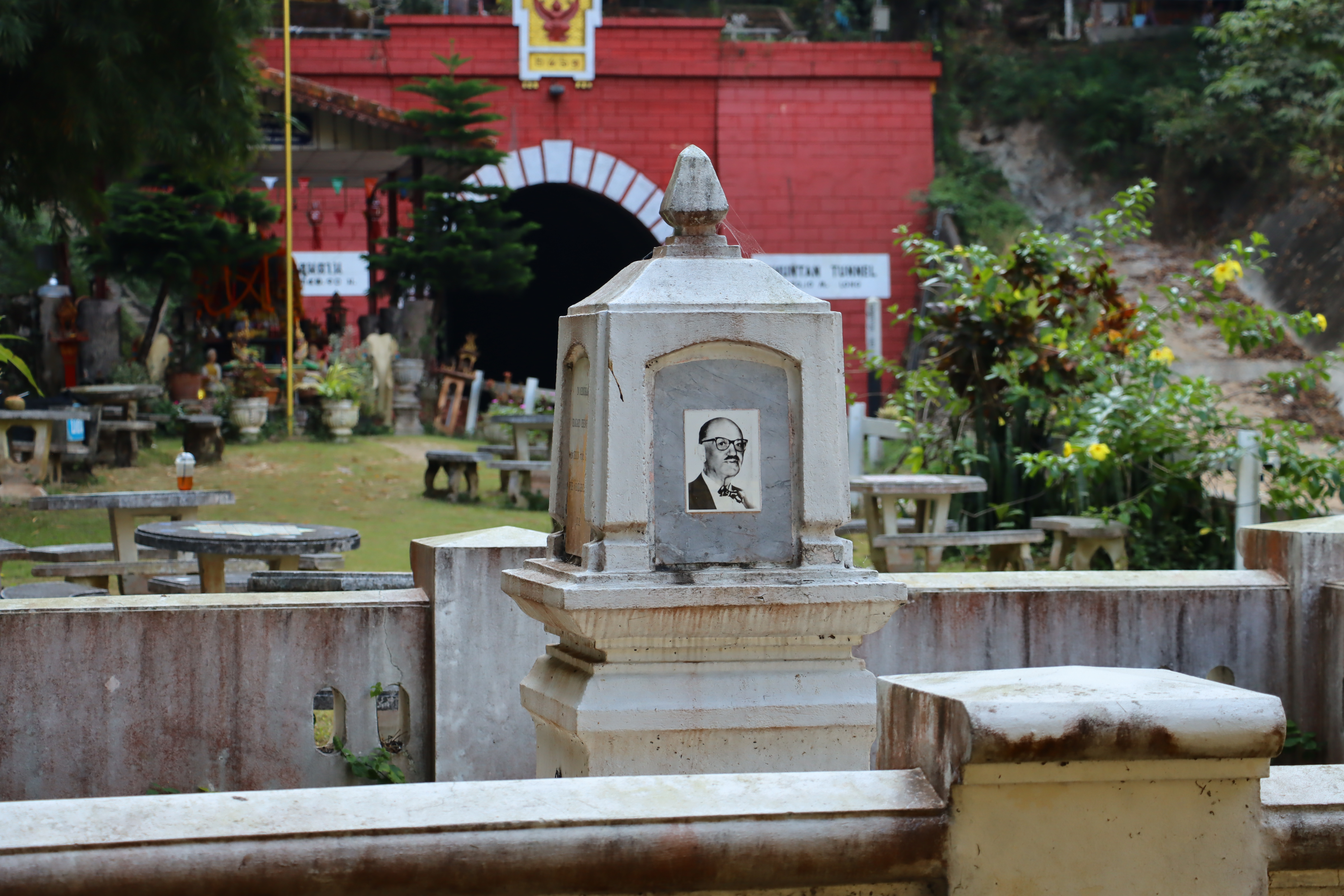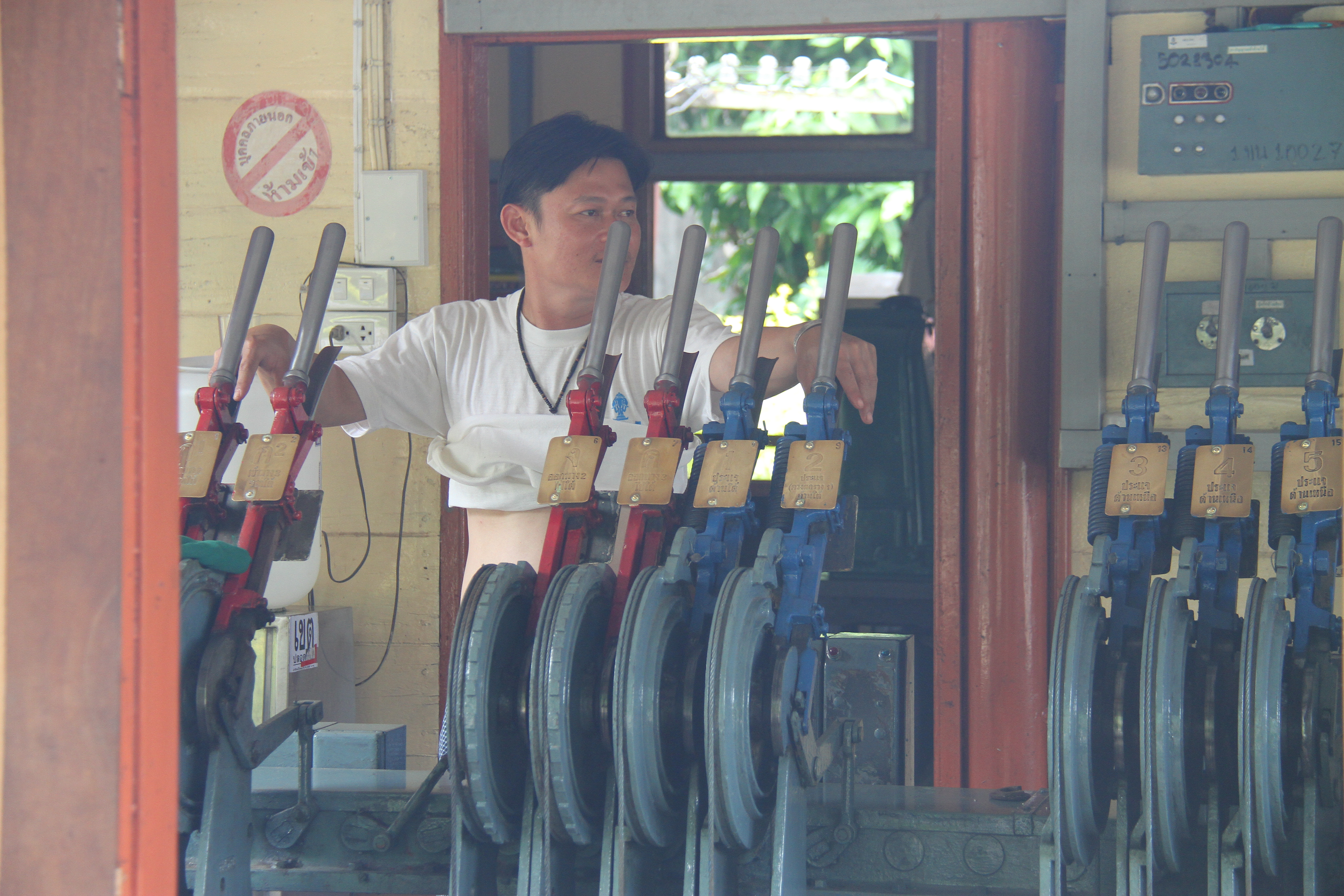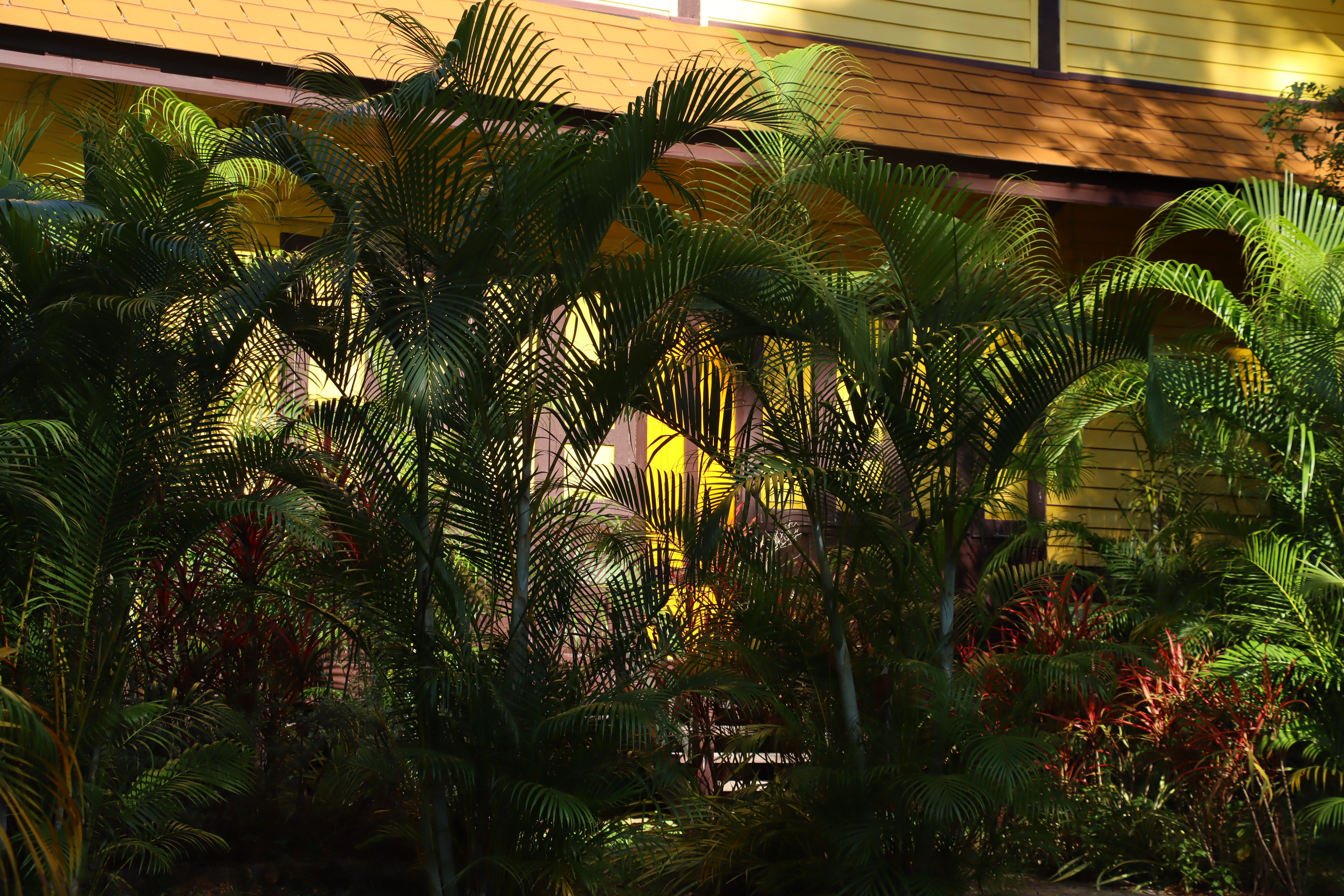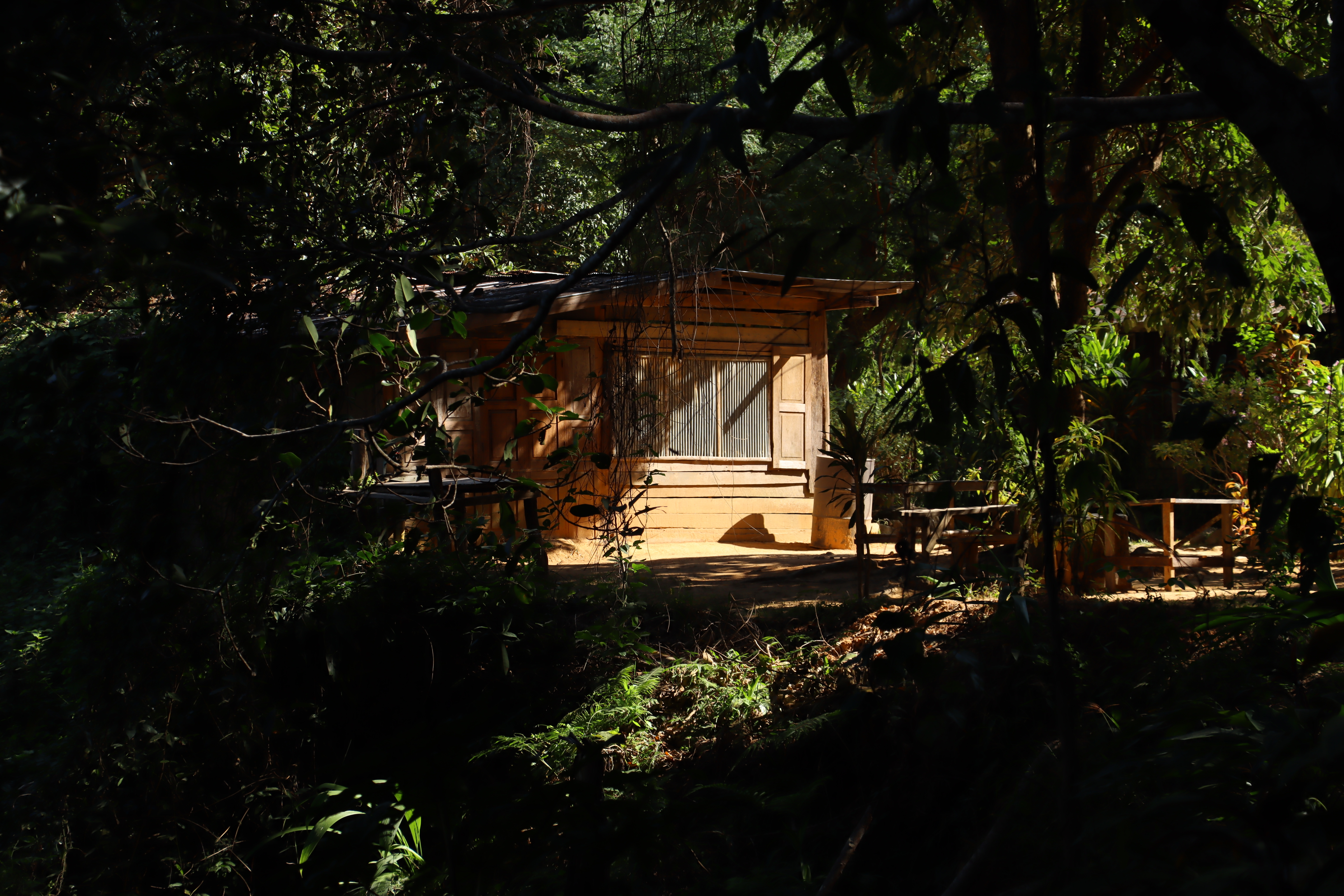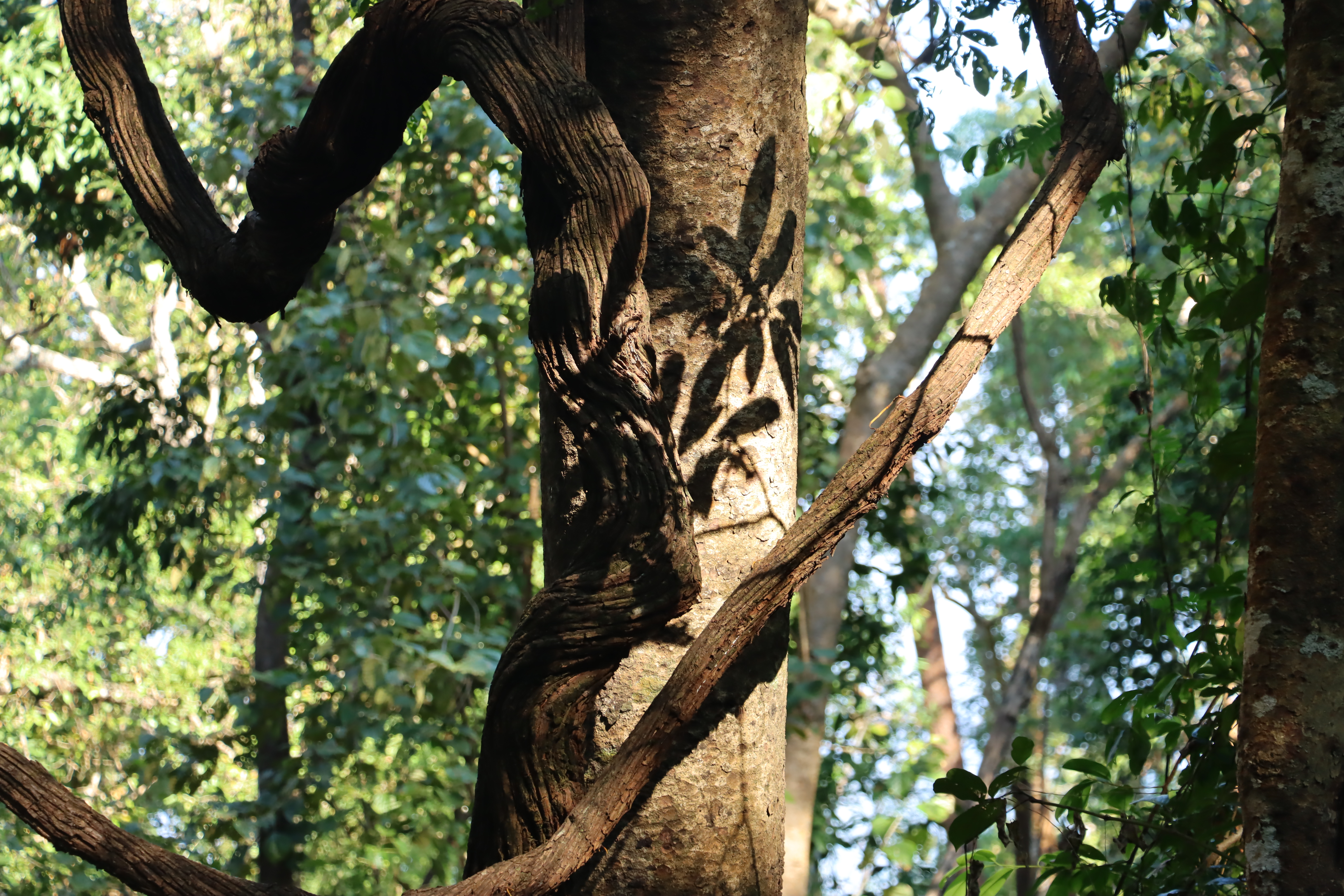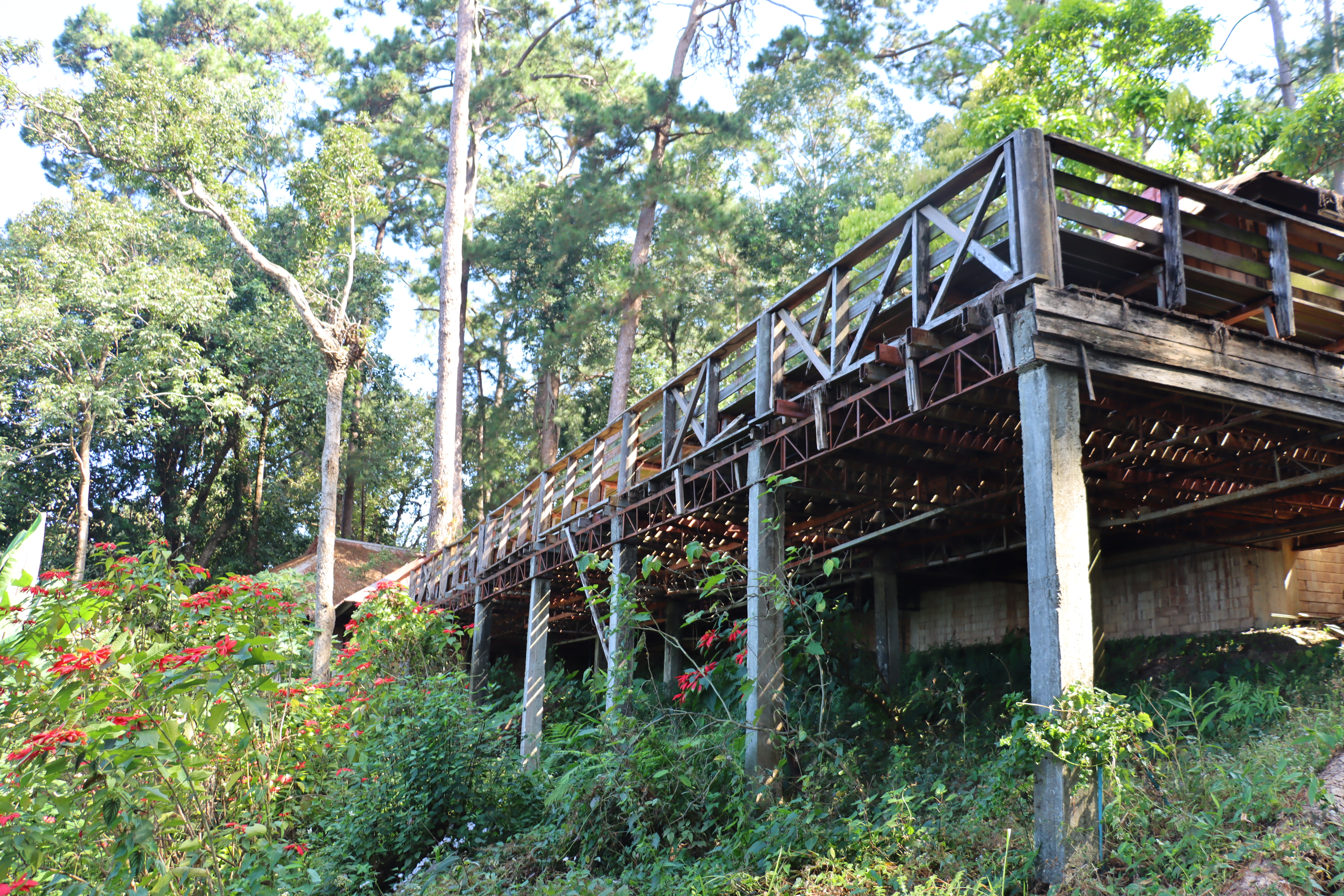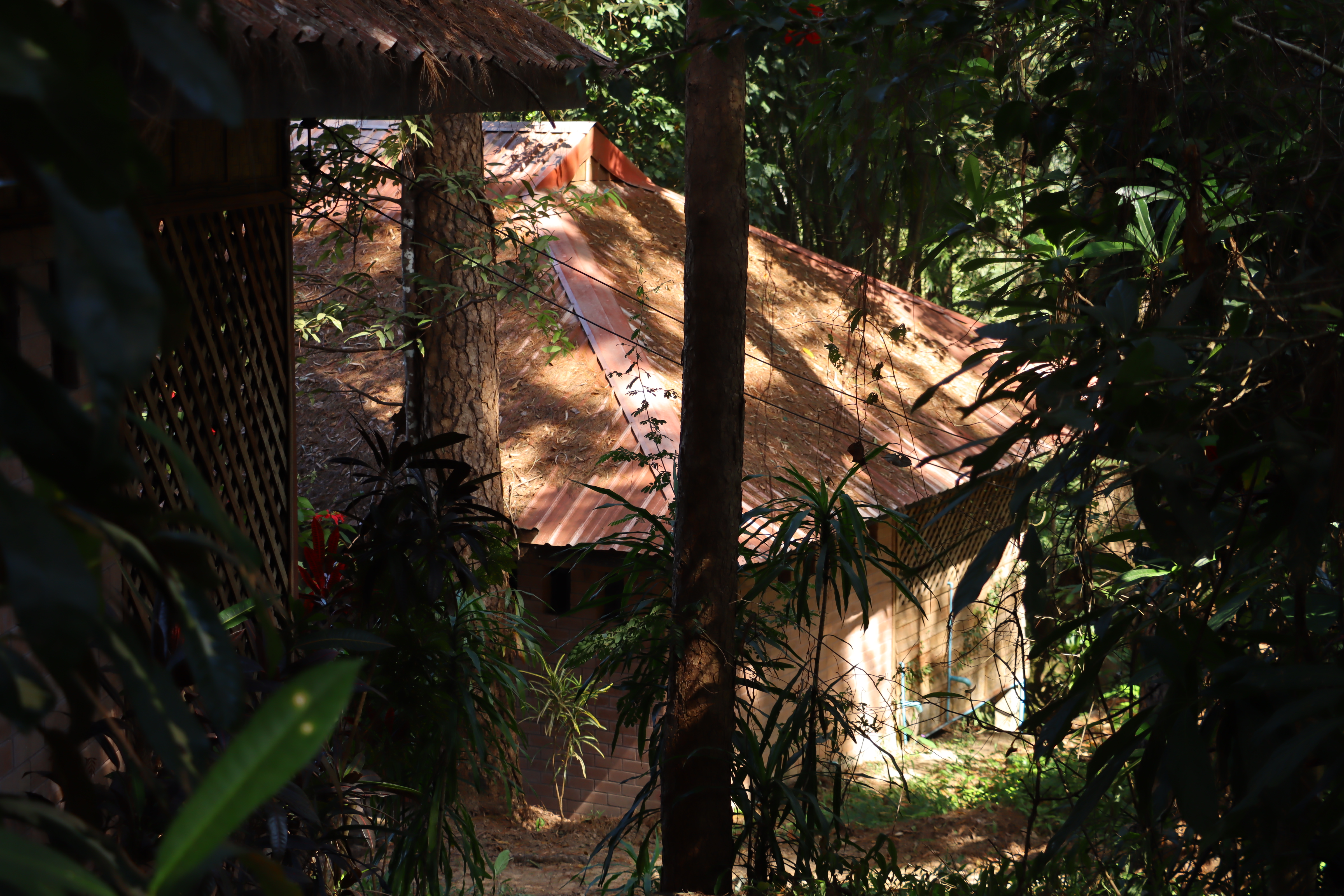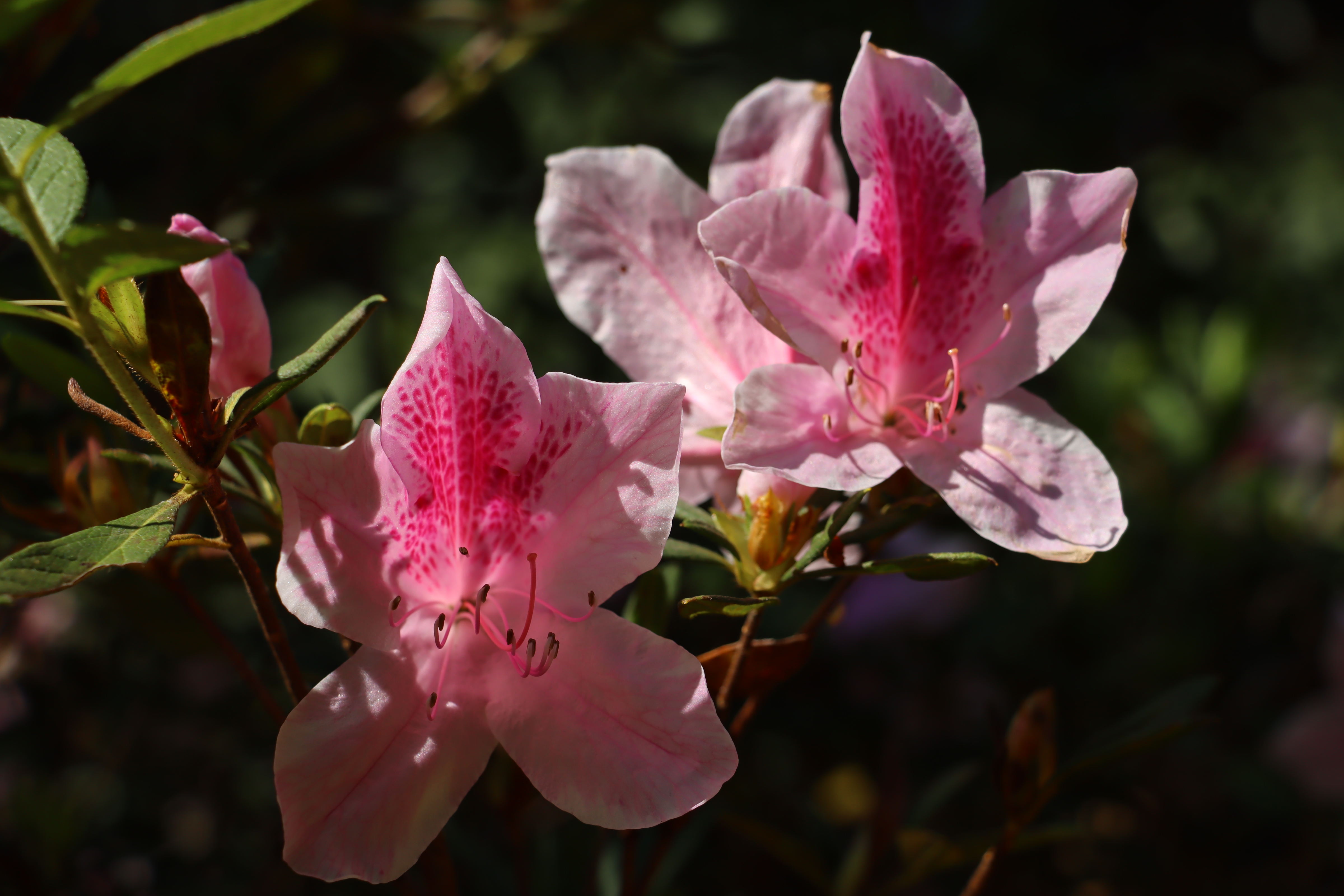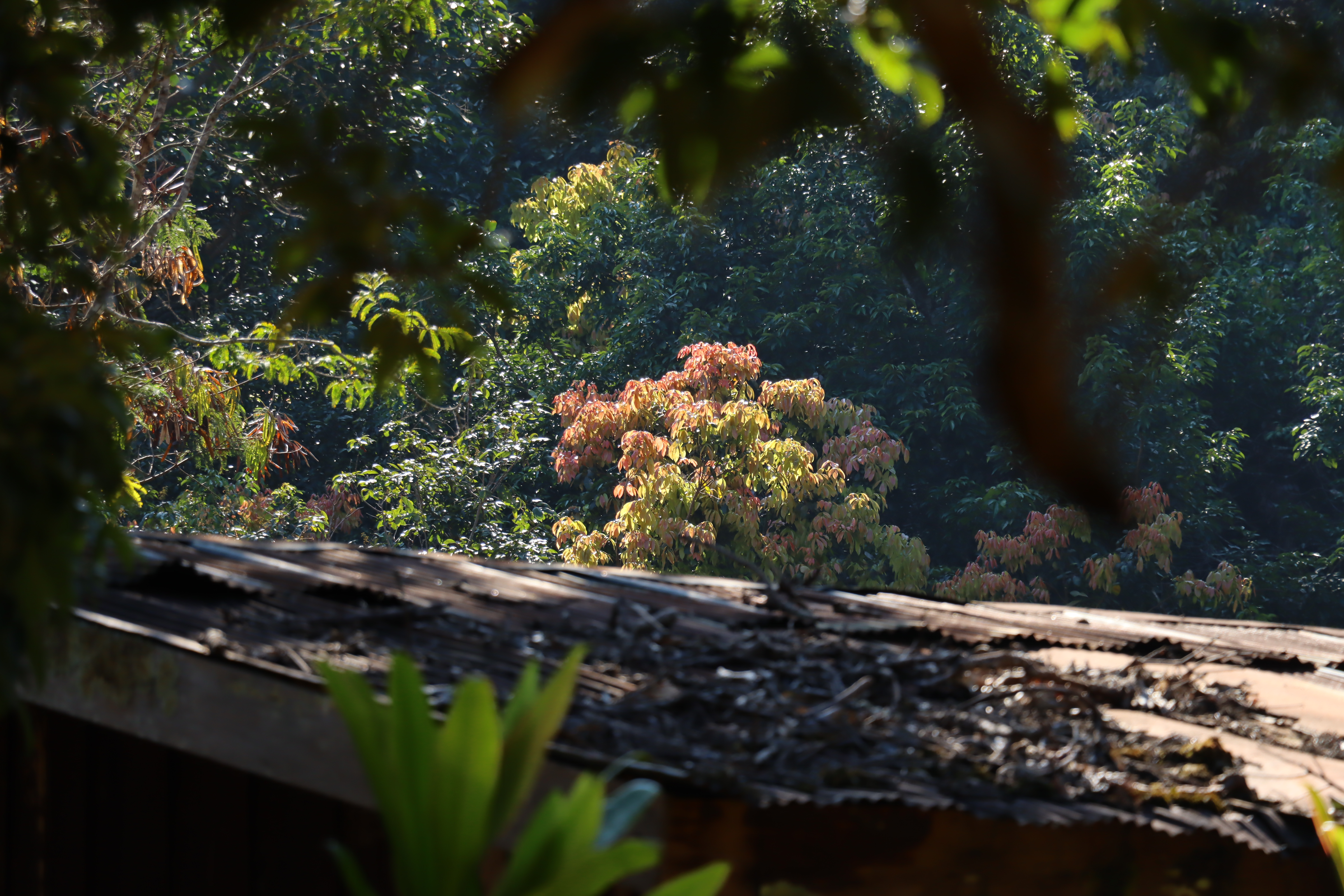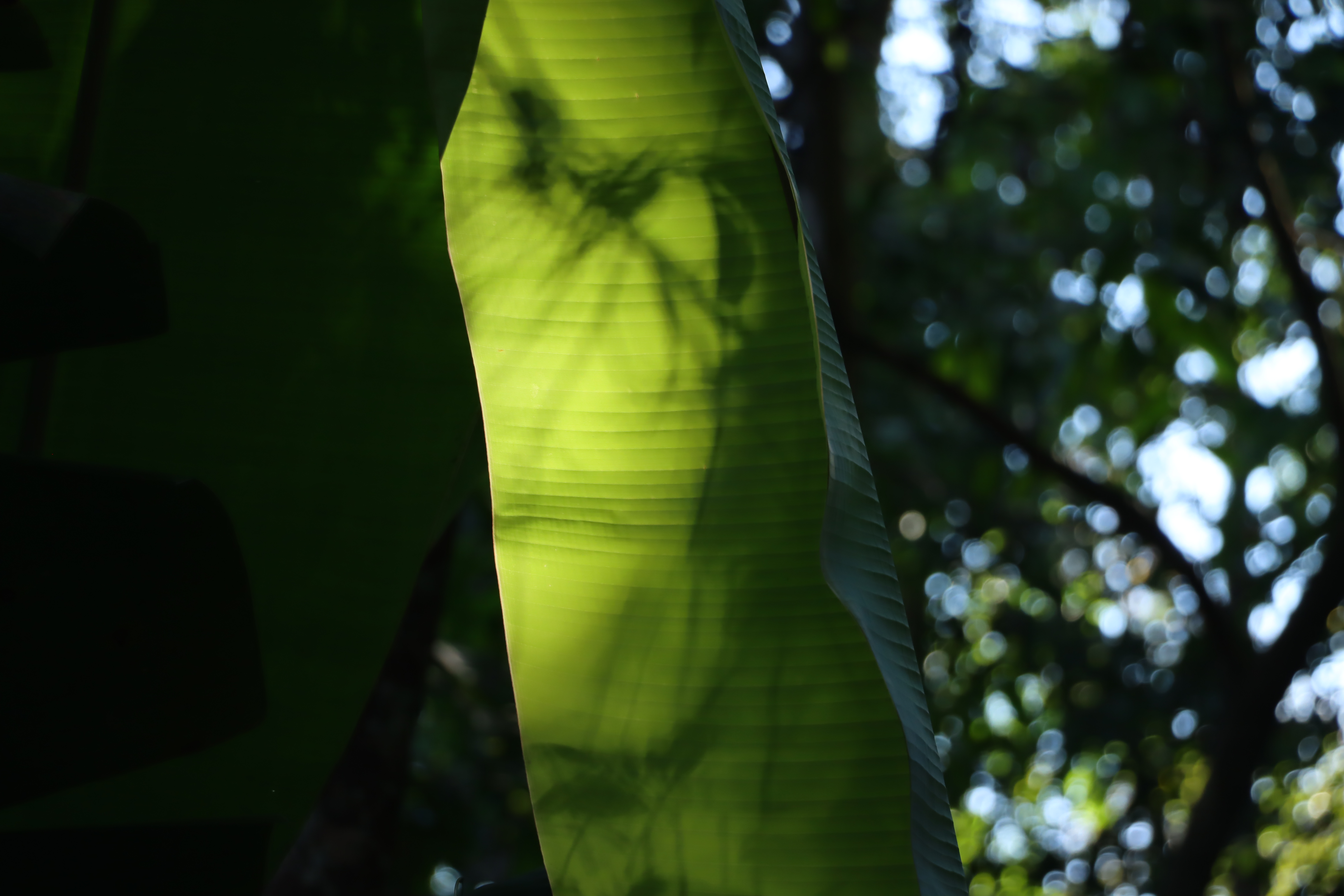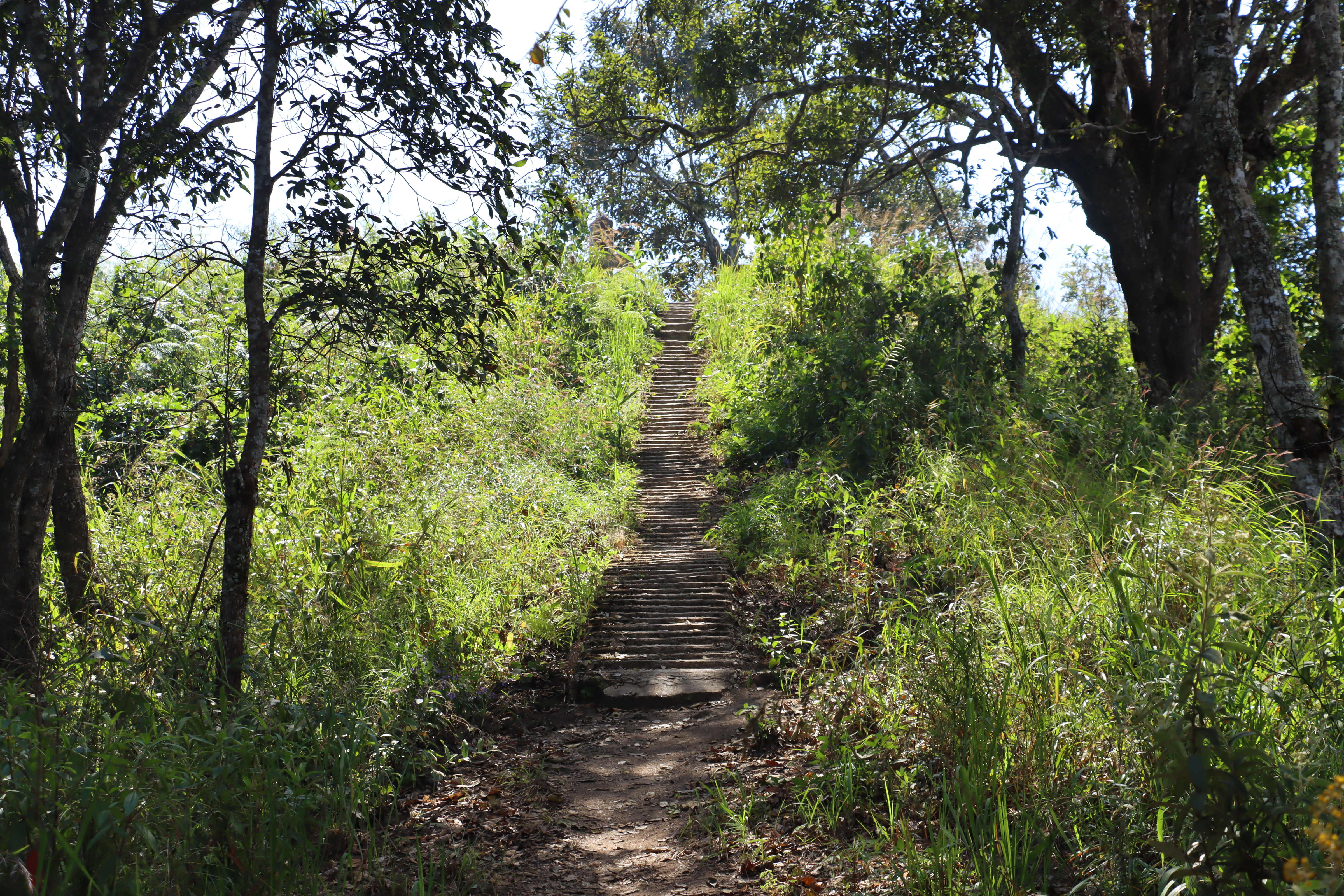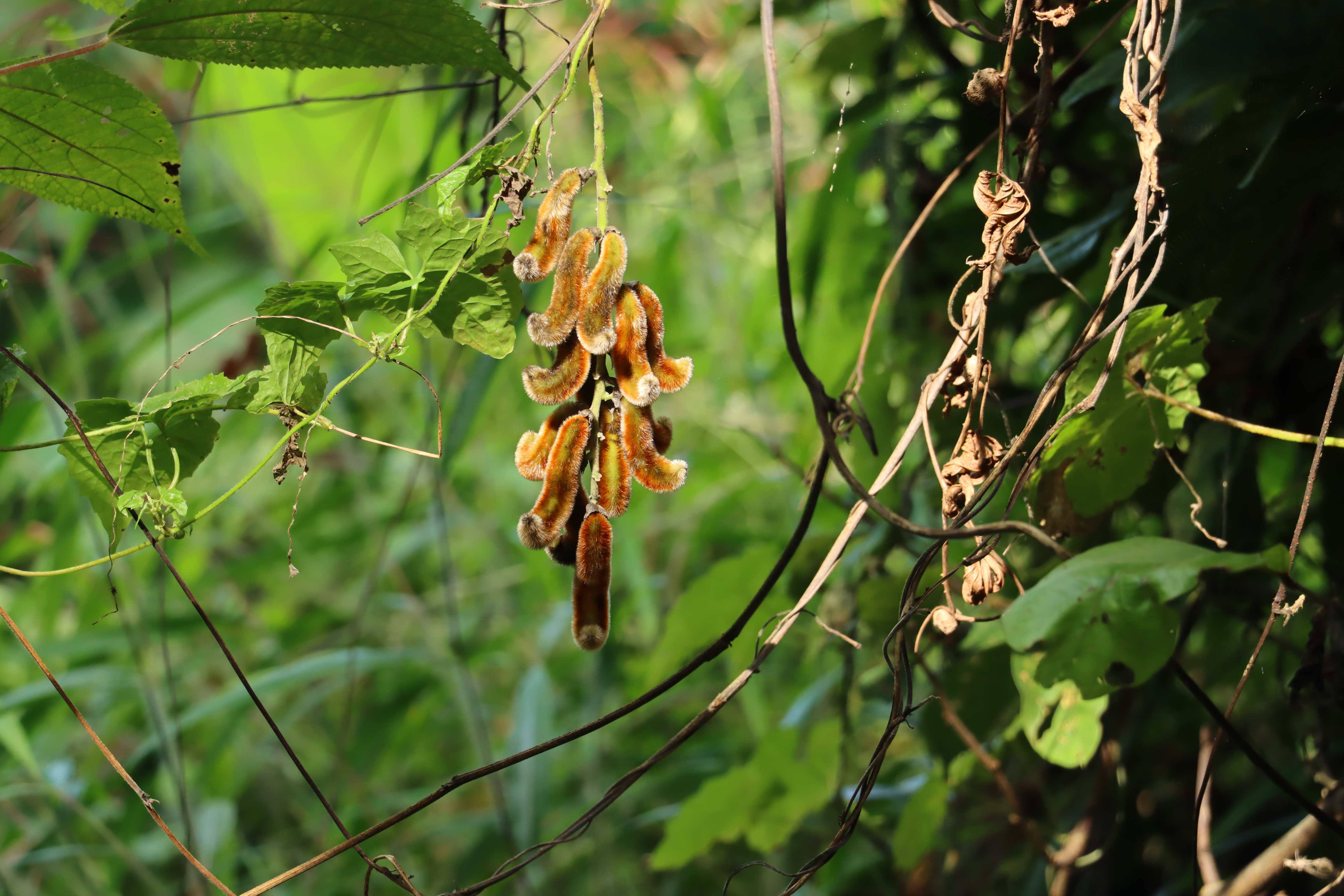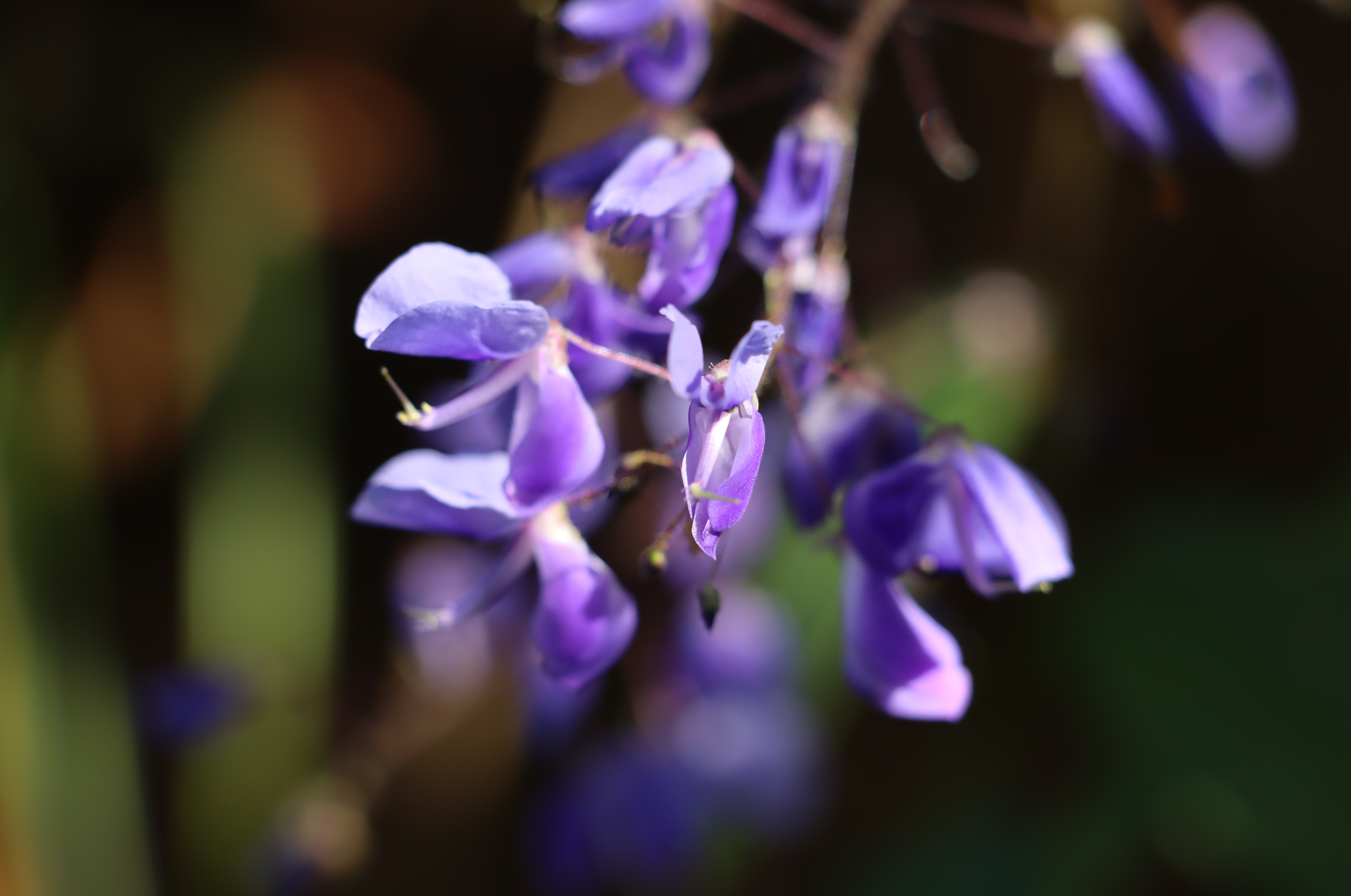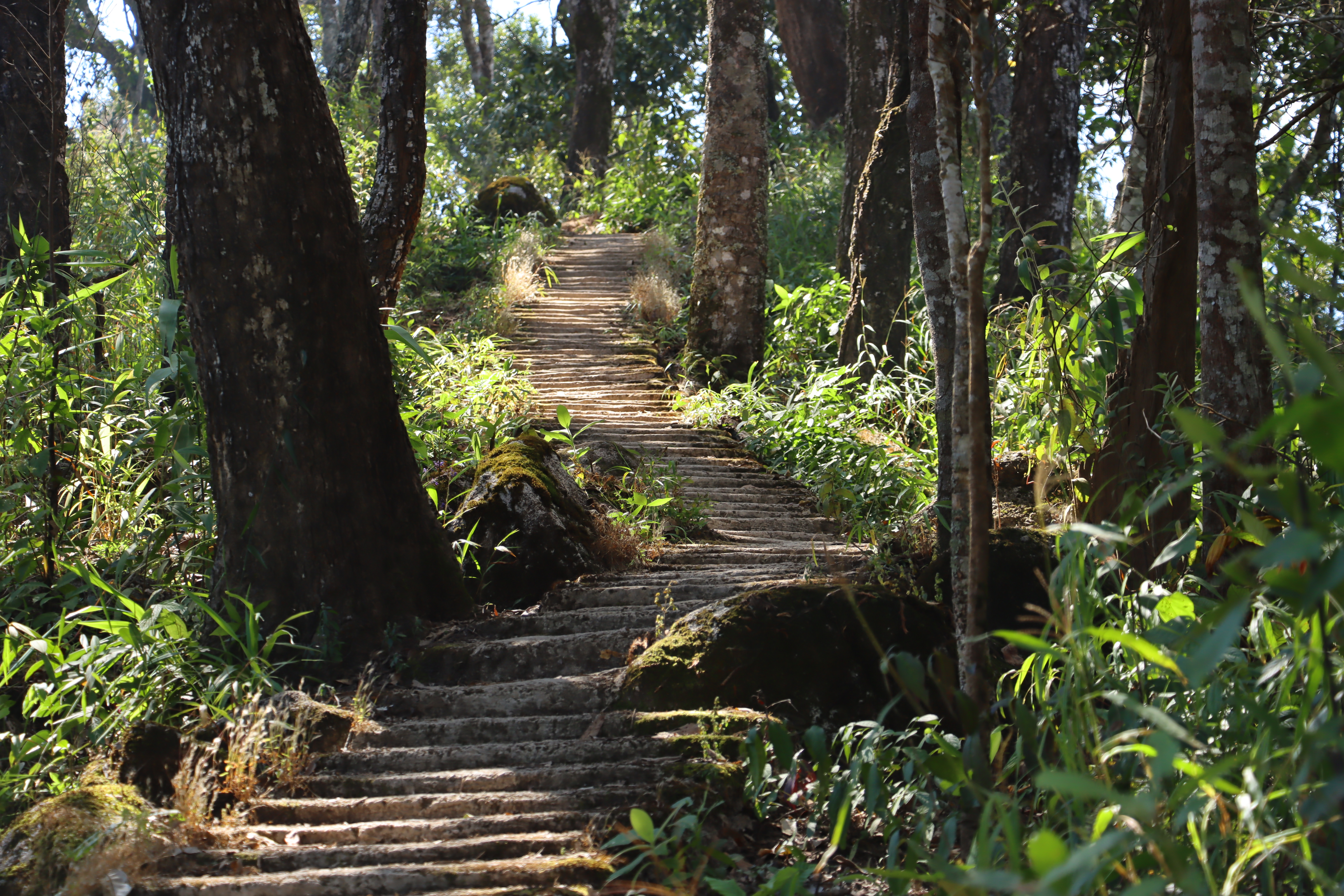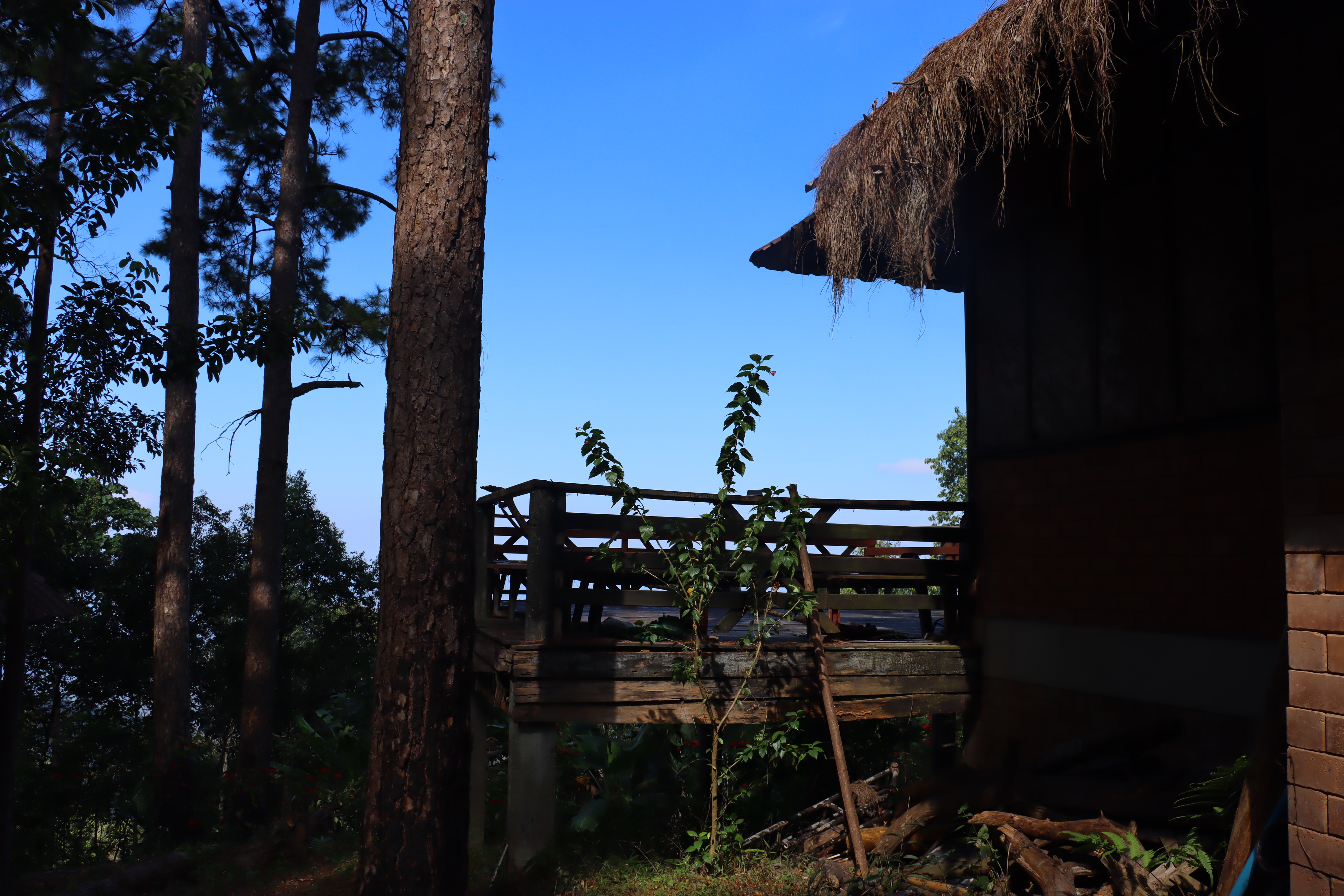A story in 6 chapters that I crafted while strolling along the paths leading to the summit of Khun Tan. I drew inspiration from actual historical events. All mentioned characters were real individuals (except for the opium-loving reverend, a creation of my imagination).
Chapter 1: Khun Tan Station and the Pierced Mountain
Our tale commences as the walker, hailing from the city of Chiang Mai, parks his blue Honda Wave near Khun Tan Station. This modest station in the province of Lamphun, nestled amidst wooded hills at the foot of the mountain, is more than just a railway station; it is the gateway to a tunnel that has left an indelible mark on the history of Northern Thailand.
Fresh from a week of Buddhist studies in a monastery in the city, the walker feels the urge to reconnect with nature to restore harmony within himself. While moments of meditation have calmed his mind, an inner force compels him to explore the Khun Tan region. Moreover, he has heard tales of a mysterious orchid that supposedly blooms only on the final slopes of Doi Khun Tan’s summit.
The walker lingers at the window of the small station, reading the schedules handwritten with a brush. There are 8 express trains passing through and stopping daily in both directions. He then strolls along the platform, observing the engine room with its open door. Manual switches pull cables along the tracks, altering the direction of the trains. His gaze then plunges into the hole: the opening in the mountain from which the railway emerges like a rigid line connecting Bangkok, the distant capital 683 kilometers away, to Chiang Mai.
Our walker had visited Khun Tan several years ago. It was during his initial journey to Chiang Mai by train. He vividly recalls the tunnel piercing through the imposing mountain. Coming from Bangkok, after leaving the plains, the railway ascends the hills, defying the elevation, in a trench cut between the rocks. Several times, it seems as if it will never reach its destination. Emerging from the tunnel, the train appears lighter, joyfully undulating towards Lamphun before reaching the terminal station in Chiang Mai.
At the dawn of the 20th century, when the small Kingdom of Lanna remained largely unexplored, its wild lands posed a challenge to travelers wishing to reach Chiang Mai. They had no choice but to navigate the Ping River on pole rafts and traverse part of the journey on elephant back. The bold construction of the Northern Railway from Bangkok was a challenge to the hilly topography. But, upon reaching the foothills of the mountain range, the only solution was to pierce through the obstacle of the majestic Khun Tan, the final barrier to connecting the Lanna region to the Kingdom of Siam.
The days when elephants led expeditions were coming to an end. As the roar of locomotives ushered in a new era, the railway opened a direct gateway from the capital of Siam. The status of the ancient Kingdom of Chiang Mai gradually faded. And travelers, nestled in iron carriages, protected from the mysteries of the wild nature, slowly lost their connection to the natural elements.
Not far from the tunnel entrance, the walker discovers a funerary monument. A stupa on which he reads the names of Emil Eisenhofer, the dedicated engineer to the excavation of this tunnel, and his wife Irmgard. Years after completing their work here, the engineer and his wife returned to Khun Tan. « Strange, » the walker thinks. « Why did these two Germans choose this place for their retirement? »
It was in 1907, during the reign of King Rama V of Siam, that the tunneling project began, a colossal undertaking that completely redefined the region’s topography.
Carved into the granite rock, the tunnel stretches for over a kilometer. Emil and his seven assigned engineers worked in this humid tropical forest, isolated from the world, with no prior knowledge of the local language. Bamboo workshops and dwellings were constructed on the hillsides.
The workers, mountaineers from the region (referred to by the Siamese as « Lao »), worked two shifts of four hours each inside the tunnel, illuminated only by oil lamps. Their bodies dripped with sweat, and their loincloths were their only clothing as they hammered the rock. Many relied on opium, accepting this substance as part of their wages. Two drills progressed at uneven speeds from both ends and finally met in November 1916. But in almost ten years, the construction site earned the grim nickname « the workers’ graveyard, » with over a thousand lives sacrificed in the heart of the mighty mountain, due to suffocation, collapse, malaria, tiger attacks, or violent quarrels.
In 1917, the house where Emil and Irmgard Eisenhofer stayed during the works, at an altitude of over 910 meters, was transformed into a vacation home. But the engineer, after leading projects in India and later in Turkey, returned here in 1930 to retire. At that time, he was not the only foreigner attracted to the Khun Tan mountain. Christian missionaries, mostly Americans, came to spend the hottest months of the year, building their vacation cabins, wooden bungalows just below the summit at nearly 1300 meters altitude.
The train is arriving! The stationmaster, standing on the platform, holds green and red flags in his hands. At this moment, the walker hears vibrations in the rails and whistles in the ascent winding through the forest. The climb is as steep as a standard rail journey allows, and the old locomotives require the assistance of a second engine to ascend. Almost all trains stop at the Khun Tan station to cool down. It is an Alstom diesel locomotive showing its orange and red front. As the stationmaster waves his green flag, the locomotive driver extends an arm through the window, passing him a kind of hoop that serves as a safety mechanism for the switches. At 578 meters above sea level, the station is the highest in the country. The faint screech of its braking echoes; it wasn’t going very fast. With a power of 2400 horsepower, its cruising speed is 100 km/h on flat terrain, but it does not exceed 30 km/h on this ascent. Manufactured in 1975, this locomotive joined the State Railway of Thailand in 1995. It pulls eight red and white wagons.
The train from Chiang Mai comes to a halt. Some young Chiang Mai residents disembark. Like our walker, they are drawn to the idea of a « return to nature. » At the train windows, the excited heads of passengers who will continue toward Bangkok become visible; some have already brandished their mobile phones, ready to film the train entering the longest railway tunnel in Thailand.
The walker buys a bottle of water and decides it’s time to take the path up the mountain. He sets out to explore the trails laid by engineers and missionaries who once admired and traversed these lands. The traces of the past welcome visitors of the present, eager to place their feet in the immortal nature.
Chapter 2: The Ascent
While our walker climbs the slope, he crosses a plateau under the tall trees where city dwellers have come to camp in the mountain’s freshness. These young people, completely dazzled by the variety of tropical flowers, turn into botanical paparazzi, taking wild selfies with orchids, tuberoses, golden acacias, and even jasmine. The young girls, smartphones in hand, approach the flowers not only to capture their own radiance in poses worthy of a Korean sitcom but also to inhale the enchanting fragrances, creating a 4G interconnection with nature.
Our walker leaves these young Thai city dwellers to their endless photo session, which will only end at nightfall, and continues his ascent into the dizzying heights of Khun Tan. The air fills his nostrils. The branches seem to play with the sun and cast dancing shadows on the vibrant colors of the vegetation.
As the trail ascends in altitude, the walker discovers patches of forest where the majestic pine forest blends with giant trees called Dipterocarps. Between 700 and 1350 meters above sea level, these splendid ecosystems reveal a landscape of unparalleled floristic and chromatic richness.
The Dipterocarps emerge above the canopy, rising majestically to 30 or 40 meters in height. Their trunks, straight and robust, stand like natural pillars. Their branches unfold only after surpassing the canopy of other species. They are like outstretched arms, with persistent leaves, above the forest.
In contrast, the canopy of the pine forest reaches heights of 20 to 30 meters, drawing a three-dimensional harmony with the giants.
Closer to the ground, the Heliconias have broad leaves and deep colors. The walker stops more than once to contemplate their red-orange flowers, which are from the same family as birds of paradise.
The walker is thus immersed in a vegetal symphony, where each species, with its distinct characteristics, contributes to the ecological balance of the region. The shades of green pine needles blend with the darker tones of the persistent leaves of giant trees, creating a tableau that evolves with each curve of the trail. The air is infused with a woody and fresh fragrance. It is an olfactory marriage between pine resin and the delicate humidity of the Dipterocarps.
Step by step, the walker increasingly feels the rough texture of the trunks under his fingers and listens to the wind’s murmur through the needles. He begins to sense the secrets of the forest at the leisurely pace of his steps.
Chapter 3: The Missionaries’ Cabins
Arriving at the pass just below the summit, the walker discovers the cabins built by the missionaries in the last century. These modest shelters were lovingly constructed in the early 20th century to provide a retreat during the hottest months of the year. The broad wooden terrace still offers a breathtaking view of the Tha River valley. Each cabin has retained its original name; for instance, the « Hannah House » was the intimate sanctuary of the couple Loren and Hazel Hannah. They lived the rest of the year at their Presbyterian mission in the city of Lampang. As fervent readers of the Bible, they shared their Christian meditations here amidst the whispers of the wind, the dancing shadows on the trees, the songs of birds, and the chirping of insects.
Lucy Starling was the first woman to become president of a mission. The sole missionary to live as a single woman, she named her cabin the « Starling Serail, » lending Persian nobility to her humble abode. It is possible that she wrote a few pages of her memoir, « Down Over Temple Roofs, » in her Khun Tan bungalow. Hailing from Kentucky, Lucy Starling arrived in Chiang Mai in 1909 and led the Christian mission in the city of Nan, where her primary activity was teaching.
Over time, the wood has aged, and the roofs have been reinforced, but the missionary cabins still stand and now serve to accommodate groups of walkers who wish to spend the night near the summit, such as the « Crooks Cottage. » Dr. Charles Crook contributed to establishing a modern hospital in Lampang, then in Nan, while his wife Florence was involved in the literacy education of the younger generations.
During the hottest months, especially between April and June, Westerners established in northern Thailand sought refuge in the cool heights of Khun Tan. Lucy Starling wrote that the journey from Nan took her 5 days of walking with ponies and another day by train.
Affixed to a wooden wall, the walker discovers what must be an excerpt from a missionary’s diary. « Khun Tan, a sacred place where nature dances with the divine spirit, » he reads as he sits down and takes out the green book he brought with him. « Khun Tan Sketch, » a booklet of about sixty pages with text and illustrations signed by Janet Greenleaf. This book is like a bible for the walker. The author, an American missionary nurse, now retired, has been living in Chiang Mai since 1973. She worked for more than 25 years at the McKean leper hospital.
Opening the book at random, he discovers a text written by Hazel Hannah in this very place sixty years ago.
« Who has not felt the gentle influence of the Pleiades on a starry night? Not so much for the quantity of light they emit but for their beauty. But who can say if beauty itself does not have the mission of elevating us towards God? These verses give me the sense of the universality of religion. Deep down, I believe that flowers, trees, clouds, the music of birds, the sound of human laughter, the murmur of streams and babies, the sensation of the breeze on the neck and arms, as well as the sweet scents rising from the surface of the earth, are not just things. They are God. »
« I have decided that if there is such a thing as reincarnation, in my first incarnation, I would be a violet, dying in winter and sprouting every spring, until becoming a true bank of violets. In another, I will be a bird. But it is so hot and humid right now, that I suppose I’ll lie down and dream. »
* This quote has been summarized; the original quote is found at the end of the text.
The walker, who had imagined the Presbyterian missionaries of the last century as diligent readers of the Bible, understands that they sought the divine beyond even the sacred texts.
Wrapped in the symphony of the mountains and its forests, the writings of the Christian missionary blend with the Buddhist teachings that the walker meditated on last week: The divine essence resides not only in sacred books but in every breath of the wind, in every leaf dancing with the breeze. The mountains are vast manuscripts; each plant, each tree, each flower is a living letter written by the universe. It is then that the walker remembers the legendary orchid that is said to bloom not far from here.
Chapter 4. Mystical Encounter in the Cave
En route to the summit of Khun Tan, exhausted by the effort of the ascent and the emotions felt on the wooden terrace of the missionaries, the walker suddenly experiences a slight dizziness. The coolness of the altitude combined with the intense physical effort has a swirling effect on his tired mind. Just when he thought his thoughts were clouding, he notices an opening in the rock, a cave hidden behind the grass. Pushed by an invisible force, he approaches, and that’s where he encounters the hermit. Inhabiting this forgotten cave in the world, the hermit seems to be a guardian of lost time between reality and legend.
Accustomed to the Buddhist temples that punctuate the landscapes of Northern Thailand, the walker expects to see a profusion of yellow Buddha statues, candles dripping with wax, and colorful offerings: but there is none of that. Alone, the hermit sitting at the center of the bare cave welcomes the walker with a profound gaze.
During their stays at Khun Tan, missionaries sometimes encountered hermits in the mountains. These hermits, followers of ancient beliefs, were considered mystics by the locals who feared them more than they respected them. The missionaries, for their part, saw these rituals in the caves as remnants of a primitive belief that they despised.
An anecdote told that a reverend, whose name I will withhold, a fervent missionary, had a particular experience in this cave. As he ventured into it cautiously, his convictions were tested by the mystical aura of the place. However, instead of succumbing to animistic influences, he allegedly claimed that it strengthened his determination to share the word of the Bible, considering the cave as a place where divine light could dispel darkness.
It was well known that many natives consumed opium, and some were frequently prone to hallucinations. Although our reverend remained silent on this matter, rumors suggested that he went to the cave to smoke opium. But it was a topic that remained secret.
Chapter 5: The Legend of the Orchid
Our walker sits in the humid silence of the cave. The hermit speaks with a voice that resonates through time. The walker cannot discern whether he is speaking Thai, English, or even French, but he understands each of his words distinctly.
« Once, when these hills were the sanctuary of spirits, before the missionaries brought their cabins and ideas, even before the chants of saffron-robed Buddhist monks, Mother Nature reigned as a sovereign, » begins the hermit. « The ancestors worshiped every leaf, every breath of wind. It was during this time that the mysterious orchid first bloomed, a gift from the gods, they said. »
The hermit depicts the orchid as a flower of enchanting beauty, with delicate petals that shimmered with a mystical glow when touched by the moonlight. « It was not just a simple plant but a manifestation of the union between the divine and nature. The ancients believed that whoever discovered it was blessed with wisdom and a deep understanding of the mysteries of life. »
In that forgotten time, the inhabitants of these mountains celebrated their gratitude toward nature and the divine spirits that protected it. These ancient prayers resonated through the valleys, harmonizing the souls of the indigenous people with the pulsations of the earth.
Reciting the hermit’s mantra, the images in the walker’s mind blur until he loses consciousness.
« Once, these hills were the sanctuary of spirits, Mother Nature reigned as a sovereign. The ancestors worshiped every leaf, every breath of wind. »…………………..
When the walker wakes up, he is lying in the grass and has lost track of time. The first reality he remembers is that he has not yet reached the summit. Gathering his strength, he rises and climbs the last meters that lead him to the highest viewpoint in the region, the place where one can see the valleys of Lamphun to the north and those of Lampang to the south. Before him, a panorama of gently curved mountains covered in forests, some villages from which a light smoke rises, and over 800 meters beneath his feet, in the depths of the mountain, in the tunnel dug more than a hundred years ago, a train undoubtedly passes.
Chapter 6: The Orchid of the Present time
What was supposed to be a simple stroll to clear the mind in the tropical nature turned into a mystical adventure, a communion with nature and its spirits. No rest for the walker who seems to absorb everything the landscape has to tell him.
At the top of Khun Tan, the slopes of the valleys light up under the fading sun. Descending the same path, the walker admires the blue and pink orchids hanging from the trees. Delicate, intricate perfections, a work of nature itself.
Orchids are born from a symbiotic relationship with nature. Their seeds require a specific fungus to germinate. In the secret corners, in the shade of the forests, this magical collaboration allows the germination of flowers considered as works of minimalist art.
Light and elegant, most orchids choose the epiphytic way of life, rising above the ground to settle on plants without exploiting them. They extend their aerial roots to feed on the moisture and nutrients from the air and rain.
This epiphytic alliance is not a parasitic relationship. The orchid simply uses the tree as a means to reach new heights, while the tree, generous, lends its shoulder without suffering damage. It’s an inter-species couple relationship where everyone lives happily.
It is through this simple botanical observation that the walker thinks he has unraveled the mystery of the Khun Tan orchid.
After nearly two hours of walking downhill, the walker notices a woman behind a wok. Tempted by the aromas of basil, grilled garlic, and chili paste filling the air until it makes him sneeze, he decides to order a dish. The woman, skillful and smiling, cooks with impressive dexterity, her wok dancing above the flames. Her dish fills the walker with happiness. He thanks the cook, who offers him a sparkling orchid branch, the finishing touch to this supernatural day. This simple and generous gesture suggests that everything in life has a reason to be. In this present, now merged with recent and distant pasts, the walker, with a smile on his face, feels the harmony that marks the conclusion of this inner journey.
The walker contemplates the mountain view one last time and carefully descends the trail. He reaches his starting point, the station where everything began this morning. Still holding the mysterious orchid in his hand, he gets back on his motorcycle. The engine purrs, breaking the peaceful silence of the mountain. He disappears into the twists and turns of the landscape, following the winding roads that snake through the hills towards Lamphun, then Chiang Mai.
As the motorcyclist’s silhouette fades away, the mountain retains the echoes of his adventure. Orchids will continue to bloom, the missionaries’ cabins will remain silent witnesses to evenings of meditation under the stars, the tunnel will continue to let trains pass, and perhaps the hermit will continue to inhabit the temporal cave. The legend of the Khun Tan orchid, now enriched by the contemporary walker’s chapter, will continue to invite curious spirits to explore the mysteries of this majestic mountain.
The text was written in 2024, and the photos were taken between 2013 and 2023 at Khun Tan. Text and photos ©Frédéric Alix.
- Enchanted Land, Foreign Writings about Chiang Mai in the Early 20th Century, by Graham Jefcoate
- Khun Tan Sketch, by Janet Greanleaf, 2007, distributed by the Payap University Book Store
The complete quote from Hazel Hannah (as transcribed in Janet Greenleaf’s book):
« Who hasn’t felt the sweet influences of the Pleiades on a starry night?
Not so much for the amount of light they send as with their beauty.
But who shall say if beauty in itself has not a mission to help us up to God? He surely wouldn’t have spent so much labor in making it if He didn’t mean it to draw us to Him.
These verses give me a feeling of the universality of religion. In my heart, I believe that flowers, and trees, and clouds, and the music of birds, the sound of human laughter, and the gurgling of brooks and babies, the feel of the breeze on your neck and arms, and the sweet smells that rise from the face of the earth; these are not just things. They are God.
The God in the rose would hear me, for once, he walked on earth and He knows all my needs. »
(…)
« I have decided that if there were such a thing as reincarnation, as the Buddhists believe, there are several things I should like to be. In the first incarnation, I would be a violet and grow in some beautiful woodland, dying in winter, and coming up dozens of new plants every spring, till I was a whole bank of violets.
In another, I shall be a ginkgo tree that lives in a temple court on a little hill overlooking the Inland Sea, where I can see Fuji Yama in the distance. It will be pleasant to shade the dear Japanese children all through the long summer, and when autumn comes, shower down my golden leaves. I’d stand watching the waves play on the shore till another spring came, then burst into glory and greenness again.
Next a pine tree on the edge of an abyss in the Rocky Mountains.
Then a butterfly. I am sure one summer, as a butterfly would satisfy me. Merely being beautiful and enjoying beautiful things can’t be interesting for long if one has no more brains than a butterfly. But Just for one summer, I should like to be one, and drink my fill of the beauty of the flowers.
In my fifth incarnation I’m going to be a bird. But it is so warm and moist just now, and I’m so sleepy, that I guess I’ll go to bed and dream. »
